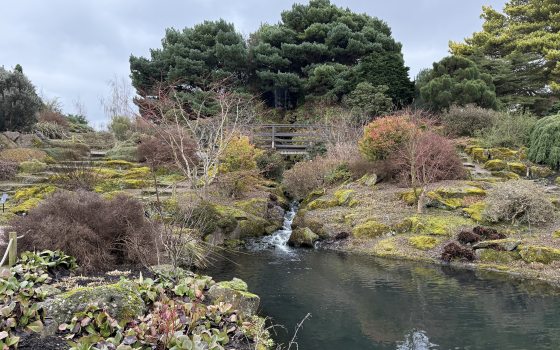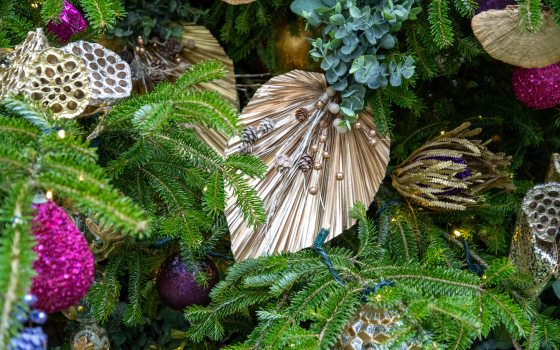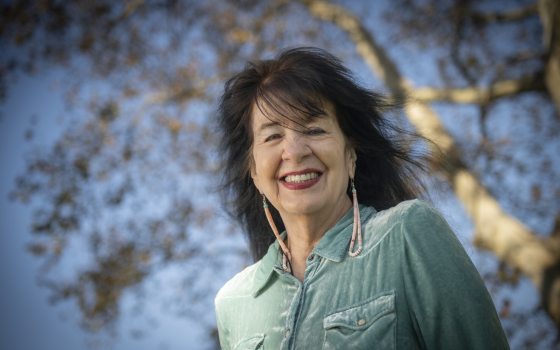As part of the Fellows Program—our unique leadership accelerator that focuses on advancing the skills and knowledge of public garden professionals—our Fellows apply their learning at Longwood and afar. Central to this application is the garden placement, during which each Fellow spends two months at a partner garden in the US or abroad. During this externship, our Fellows study and learn about their host organization and its structure, culture, and approach to staff management and leadership—all while contributing to their host organizations by applying leadership skills and knowledge learned at Longwood. Here, our Fellows reflect on all the discoveries and memories made during their placements around the world. From arriving in Edinburgh to study tree risk only one week after the city’s strongest storm left many uprooted trees in its wake; to learning firsthand about Singapore’s evolution from a Garden City, to a City in a Garden, and now a City in Nature; to diving into a living museum of botanical wonders, here are the stories of our 2024–2025 cohort.
Laurel Dunning
Royal Botanic Garden Edinburgh (Edinburgh, United Kingdom)
During my first visit to Royal Botanic Garden Edinburgh (RBGE)—lovingly known as The Botanics, sitting proudly in the heart of the city—I wandered around feeling amazed at the beautiful garden where I would spend the next two months! Drawn through winding paths of the Rock Garden (as shown in the first image of this post), past alpine plants tucked into stony crevices and a waterfall tumbling through a hillside, I came upon a grove of Giant sequoias—planted in tribute to fellow Californian and conservation icon, John Muir. It stopped me in my tracks.
As a native of California, I’ve always felt a kinship with Muir’s writings, but standing beneath trees that linked his Scottish beginnings to his American legacy made something click for me. In that moment, I understood my garden placement not just as an academic or professional opportunity, but as a personal journey—an arc rooted in both place and purpose.
Over 350 years old, The Botanics began as apothecary garden, with every plant in the collection serving a purpose in science. Today, RBGE builds upon that legacy as a global center for biodiversity, science, conservation, horticulture, and education. One week prior to my arrival in Edinburgh, the most powerful storm in a decade had barreled through Scotland, with Storm Eowyn uprooting giant trees across all four of RBGE’s gardens and leaving a trail of battered glasshouses in its wake.
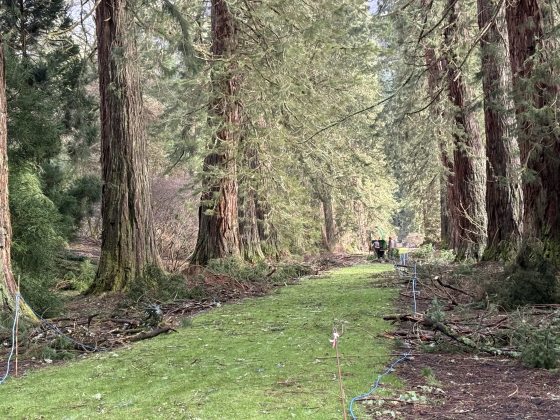
Cleaning up damage from Storm Eowyn in the 162-year-old Redwood Avenue at Benmore Botanic Garden, part of the RBGE. Photo by Laurel Dunning.
Storm Eowyn emphasized the relevance of my garden placement project, which was updating RBGE’s 2014 Tree Risk Management Strategy, particularly in two key areas: the objective assessment of tree risk, and the more subjective—but equally critical—evaluation of a tree’s value. As David Gray, Senior Horticulturist at Benmore, reminded me, “You have to be careful not to assess the risk, but to assess the asset.” That philosophy guided every conversation, every site visit, and every revision during my placement.
Perhaps the most profound lesson I learned from the arborist teams at both Longwood and RBGE is the mindset of opportunity. With every tree lost, a new opportunity emerges—space to plant something better suited to a changing climate, to enhance the visitor experience, or to strengthen the resilience of the collection.
I had a front-row seat to the massive undertaking of the Biomes Project, a restoration of RBGE’s historic glasshouses. I was privileged to have a space with RBGE Research Collections and Project Manager—and Longwood Fellows alum—Sadie Barber and Biomes Glasshouse Manager Fiona Inches in an office overlooking the construction zone, where scaffold-clad glasshouses are slowly being reborn. It reminded me of my time as a design and planning intern at Longwood Gardens back in the early 2000s, working on the East Conservatory renovation. That experience came full circle when I returned to Longwood last year just in time for the opening of the new West Conservatory.
Getting a sneak peek inside RBGE’s Biomes was a highlight—especially after delays caused by the storm. Walking through those spaces on a tour with Fiona and realizing the scale of restoration and the intricacy of each step filled me with awe and appreciation for the sheer complexity of public garden infrastructure.

My office view of the Biomes glasshouse restoration. Photo by Laurel Dunning.
There’s a lovely sense of reciprocity between RBGE and Longwood. I loved hearing from staff who had been through Longwood programs reflecting on their time spent at Longwood and their stories. Each year, Longwood sends seeds of its prized Victoria waterlilies to RBGE, where they’re grown and shared among staff and students, even while the glasshouses are closed to the public. I met RBGE team members who had participated in Longwood’s Education and Leadership programs, their eyes lighting up with memories of Pennsylvania summers and professional milestones. This spirit of collaboration and exchange is at the heart of what makes our field so dynamic—and so human.
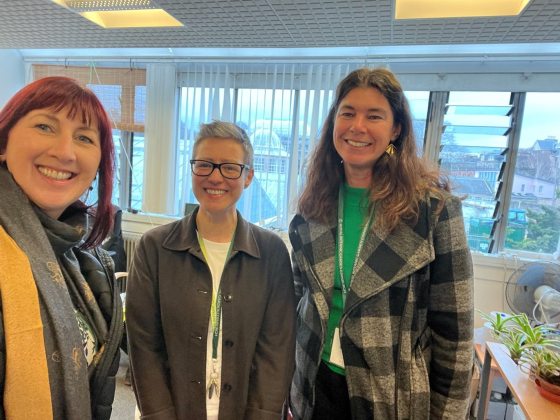
From left, Fellow Clare Shearman, RBGE Research Collections and Project Manager (and Fellows alum!) Sadie Barber, and Fellow Laurel Dunning. Photo by Clare Shearman.
RBGE is in the midst of major transitions. The storm damage was just one piece of a larger story. The historic glasshouses are undergoing restoration as part of the ambitious Biomes Project. A new Living Collection Policy has just been released. Staff leadership is evolving. Change was in the air. And yet—what impressed me most wasn’t the upheaval but the resilience. Teams were already clearing hazardous limbs, triaging collections, and pressing forward with a clear sense of mission.
One of my biggest takeaways from this experience is that tree risk management is never just about an individual tree. It’s about understanding the ripple effects—how a single decision touches biodiversity, visitor safety, landscape aesthetics, staff workload, and even institutional identity.
As John Muir wrote in My First Summer in the Sierra: “When we try to pick out anything by itself, we find it hitched to everything else in the Universe.” This couldn’t be more true. My work at RBGE has deepened my understanding of how science, horticulture, and heritage converge—and how public gardens are constantly adapting to serve both people and plants in an ever-changing world.
The two months of my garden placement have been among the most rewarding of my life. I left Scotland with new skills, lifelong connections, and an even greater understanding and respect for the work we do in public gardens from a global perspective. I look forward to carrying this experience with me as I return home to California after graduation and continue the next chapter of my career.
Vânia Pereira
The Morton Arboretum (Lisle, Illinois, USA)
For my garden placement, I hoped to be immersed in a world of botanical garden research fueled by excitement for saving species—and that’s exactly what I found at The Morton Arboretum (TMA) just outside Chicago. Located on 1,700 acres, TMA is an internationally recognized tree-focused botanical garden and research center. What truly made it special, though, was the people: a team of kind, passionate experts dedicated to making a difference in the world of plant conservation through science.
Arriving in February, in the harsh heart of winter, was a challenge. But within my first few days, I was amazed to see the grounds bustling with visitors skiing and snowshoeing across the snow-covered landscape. As spring slowly emerged, so did more visitors, drawn to the Arboretum’s beautiful landscape and majestic trees.

Fellow Vânia Pereira at The Morton Arboretum. Photo by Kris Bachtell.
I joined the Science and Conservation team, working closely with the Global Tree Conservation Program (GTCP)—an incredible group collaborating with stakeholders around the world to drive vital, on-ground conservation actions. Being part of the GTCP allowed me to attend several key conferences and visit other inspiring botanical institutions. Highlights included the MetaCollections Ex Situ Gap Analysis Training Workshop at the Atlanta Botanical Garden, the Global Tree Specialist Group Strategic Meeting for The International Union for Conservation of Nature at TMA, the iLandscape Conference in Chicago, and the International Plant Conservation Conference at the Missouri Botanical Garden. These experiences not only deepened my understanding of global conservation strategies but also helped me to build meaningful national and international connections with other garden professionals.
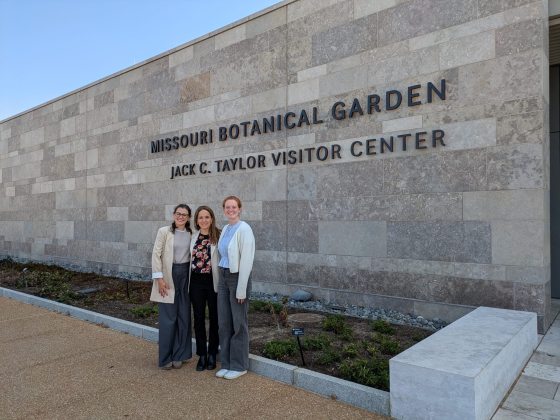
From left: Fellow Vânia Pereira, The Morton Arboretum Global Tree Conservation Program Director Silvia Alvarez-Clare, and Global Tree Conservation Program Manager Amy Byrne while visiting Missouri Botanical Garden. Photo by J. Sebastian Tello.
My main project I worked on at TMA was an assessment of interdepartmental cooperation from a global tree conservation program perspective. Since 2022, GTCP has aimed to strengthen cross-department collaboration, and I was tasked with evaluating the progress of this effort three years later—examining the impacts, benefits, and challenges, and offering insights to guide future strategies.
This project gave me the chance to engage deeply with TMA staff across five departments. I conducted 22 interviews, ranging from managers and directors to scientists and Ph.D. students. These individuals represented three categories: those actively collaborating with GTCP, those who had attempted collaboration but faced obstacles, and those with no prior collaboration experience. Through these conversations, I learned not only about the projects underway but also about the staff’s career paths and their perspectives on teamwork.
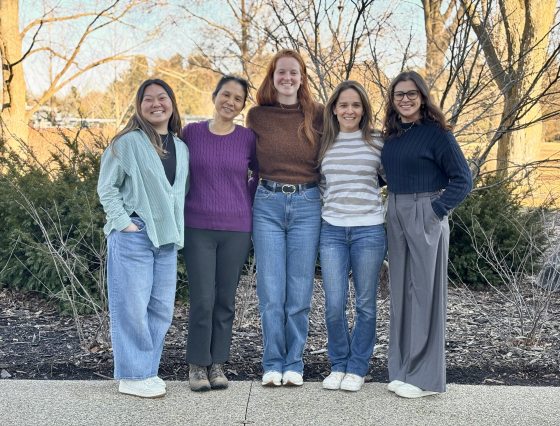
From left: The Morton Arboretum GTCP team Angie Wang, Chai-Shian Kua, Amy Byrne, and Silvia Alvarez-Clare with Fellow Vânia Pereira. Photo by Ellyn Fortino.
During my placement, I was excited to be able to directly apply the skills and knowledge I’ve gained during my year in the Fellows Program—especially around relationship-building and understanding the multifaceted nature of botanical garden management. What emerged clearly was that successful collaboration depends on trust, mutual respect, early planning, and transparent communication. GTCP’s collaborative efforts have already achieved meaningful outcomes, and by fostering inclusive, early-stage partnerships and strengthening internal relationships, the GTCP team and the Arboretum are well-positioned to significantly expand their conservation impact, both locally and globally.
My time at The Morton Arboretum was truly transformative. The people I met, the lessons I learned, and the moments I experienced are things I will carry with me always. It was an unforgettable opportunity—and one I will cherish forever.
Anastasia Sallen
Gardens by the Bay (Singapore)
If you have ever searched “Singapore” on the internet, you have most likely seen an image of Gardens by the Bay’s iconic Supertrees. I had the incredible opportunity to spend my placement learning from the passionate team that steward this extraordinary garden in Southeast Asia.
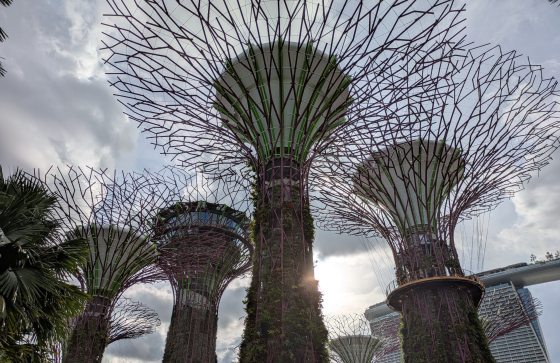
Supertrees at Gardens by the Bay. Photo by Anastasia Sallen.
During my time at Gardens by the Bay, I had the opportunity to see the gardens from many different perspectives. Rather than doing one project, I was immersed in teams across the organization, learning from team members in Membership & Volunteers, Education, Research & Horticulture, Conservatory Operations, and Gardens Operations. During my eight weeks, I shadowed staff from a wide range of departments, gaining insight into school and youth programs, community outreach programs, volunteer programs, interpretation, and horticultural research, as well as horticultural design, installation, and maintenance.
It was an exciting time to be at Gardens by the Bay. While I was with the Conservatory Operations team, I experienced the culmination of the Spring Blossoms: Legend of Lady White Snake display and the installation of the Sakura display in the Flower Dome. (Sakura means both “cherry trees” and “cherry blossoms” in Japanese.) The Sakura display is a celebration of cherry blossoms, filling the Flower Field with a cloud of white and pink blooms. I learned that timing is critical to the Sakura display. Trees arrive with bare branches, but with the diligent care of skillful horticulturists, bloom just in time for the opening of the display. The scale of the Sakura installation was remarkable. I will never forget witnessing full-sized trees being lowered into place by a crane in the Flower Dome.
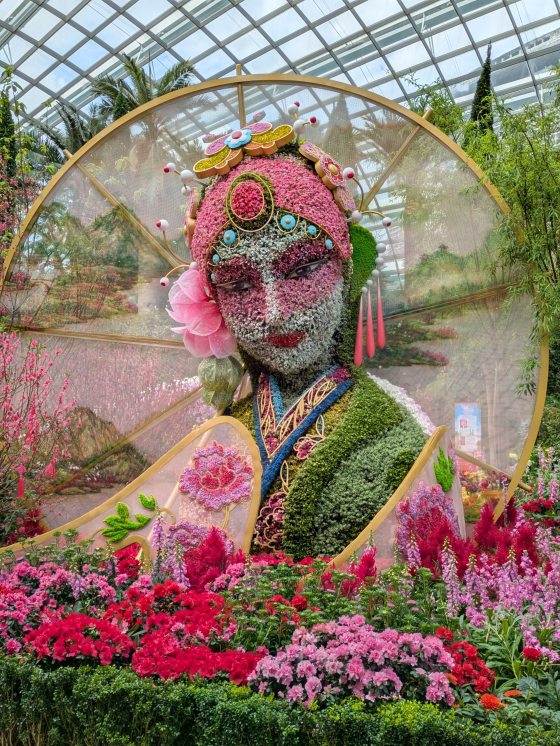
Spring Blossoms: Legend of Lady White Snake display in the Flower Dome at Gardens by the Bay. Photo by Anastasia Sallen.

Fellow Anastasia Sallen with the Sakura display in the Flower Dome. Photo by Cheyanne Sih.
Throughout the Fellows Program, we have discussed the benefits of taking a step back from day-to-day operations to look at organizations more holistically. Because I rotated through different departments, Gardens by the Bay provided me with an opportunity to look at how different teams operate and interact as part of a larger whole. Through conversations with staff, volunteers, partner organizations, and visitors, I gained a deeper understanding of how everyone works together to realize Gardens by the Bay’s vision to be “a world of gardens for all to own, enjoy, and cherish.”
One of my favorite places in Gardens by the Bay was Kingfisher Wetlands. Filled with mangroves, it reminded me of home in coastal Florida. Interpretive signs share the important role mangroves play in sequestering carbon and supporting climate resilience. The wide array of biodiversity attracts photographers waiting patiently for the perfect photo. These man-made wetlands demonstrate Gardens by the Bay’s commitment to conservation and sustainability.
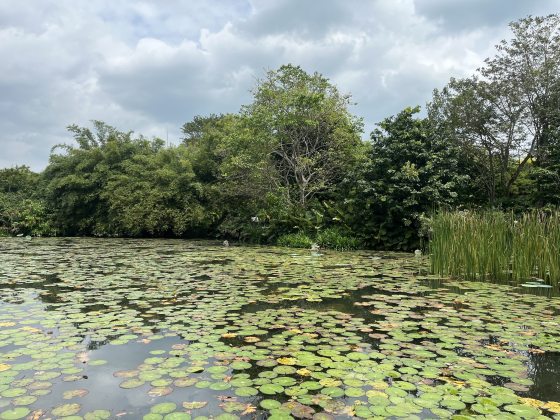
Kingfisher Wetlands at Gardens by the Bay. Photo by Anastasia Sallen.
Singapore is known as a green city. Throughout my time in Singapore, I heard about Singapore’s evolution from a Garden City, to a City in a Garden, and now a City in Nature as part of the Singapore Green Plan 2030. People I met during my placement had no shortage of recommendations of nearby natural areas to explore, and I followed their advice, visiting Bukit Timah Nature Reserve, Sungei Buloh Wetland Reserve, and Central Catchment Nature Reserve, witnessing firsthand the incredible wildlife supported by these green spaces. Gardens by the Bay has been an integral part of this evolution.
From building more inclusive and accessible community programs to advancing sustainability initiatives, Gardens by the Bay is a place where leaders at all levels are innovating. It was a privilege to learn from such a talented team.
Clare Shearman
Royal Botanic Gardens, Kew (London, United Kingdom)
My Fellows Program journey brought me to Royal Botanic Gardens, Kew for a two-month placement, and I couldn’t have been more excited to dive into the world of collections—something I’ve focused on for the past six years. For me, it was a dream come true to experience a day in the life at Kew. With each step, I encountered awe-inspiring sights, sounds, and stories that made every moment memorable.
You can’t step foot in Kew without feeling the passion for science, history, and education that the gardens radiate. This dedication is reflected not only in its landscape and plants but also in the most important component: the people who work there. With its centuries-old history, sprawling landscapes, and iconic trees, Kew truly feels like a living museum of botanical wonders. Add to that the four remarkable glasshouses, each showcasing unique plant zones from around the globe, and you can imagine why Kew is a must-visit destination for any nature enthusiast.
Located in West London in a riverside flat section of 121 hectares of beautiful walled landscape, Kew Gardens isn’t just a beautiful place to visit; it’s deeply steeped in history. Dating back to the 18th century, Kew has been at the forefront of scientific research, conservation, and plant exploration. Walking through the gardens, I could feel the weight of its rich heritage—from the historic buildings to the towering trees that have stood for generations.
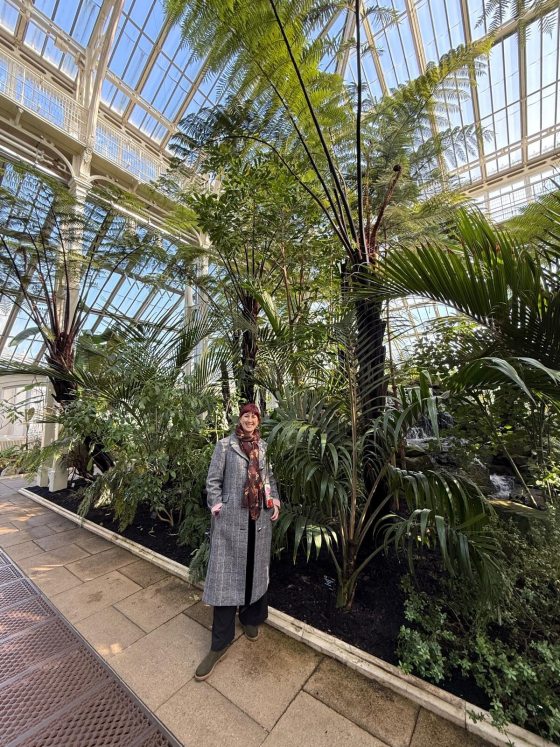
Fellow Clare Sherman in the Palm House at Royal Botanic Gardens, Kew. Photo by Laurel Dunning.
During my time at Kew, my role was to assist in developing their Living Landscape Plan, a key initiative designed to guide managers in maintaining and evolving various elements of the landscape. This plan covers not only aesthetic and cultural considerations but also technical aspects like climate resilience and botanical value.
My love for history took over, as I firmly believe that understanding the past and the present is essential before moving into the future. I spent much of my time researching how Kew came to be, examining the jigsaw pieces that have shaped the gardens and landscape over the years.
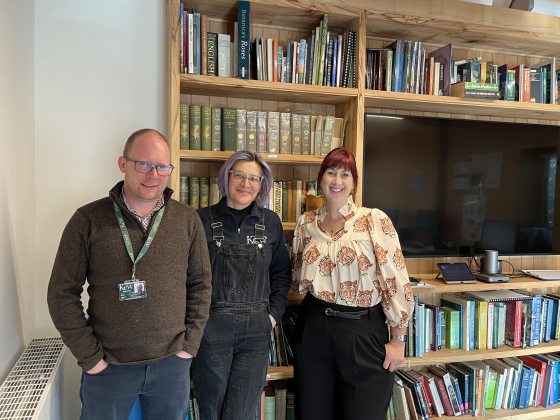
From left, Head of Tree Collections for Royal Botanic, Kew Kevin Martin; Arboretum Supervisor for Royal Botanic, Kew Valarie Boujard; and Fellow Clare Shearman. Photo provided by Clare Sherman.
When I wasn’t peering out of the office window, I was immersed in researching and developing a design guide for the landscape. Next, I focused on categorizing and outlining principles to help shape a document that would guide the future of Kew’s collections.
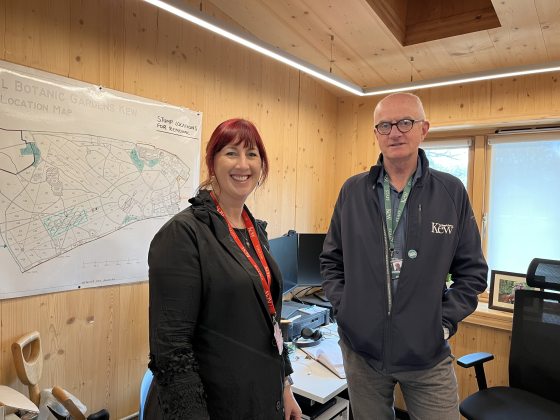
From left, Fellow Clare Shearman and Curator of Living Collections for Royal Botanic, Kew Simon Toomer. Photo provided by Clare Shearman.
Connecting with the various teams at Kew was essential for gaining a comprehensive understanding of the scope of the Living Landscape Plan. Drawing on my learnings from Longwood about leading with questions, I created a web of questions designed to encourage a holistic view of the gardens, allowing me to step back and assess the bigger picture. I then dug deeper into specific areas each team manages, exploring collections, the visitor experience, and the impact of climate change—something that is already evident in Kew’s landscape.
The two months flew by, and I am incredibly grateful for the experience I had with the Kew Living Collections Teams. I spent valuable time behind the scenes at Kew Gardens, and as someone with my heritage rooted in the UK, leaving was a bittersweet moment. I left with a heartfelt “see you soon,” knowing I’ll be back. Whether to check in on the fantastic team or to see how the landscape and collections continue to evolve, I know Kew will always be a place I will return to.
E. Yvette Weaver
The Alnwick Garden (Alnwick, United Kingdom)
From my very first conversation with The Alnwick Garden’s Chief Executive Officer Mark Brassell and Head of Human Resources Stephen Telford, I knew that The Alnwick Garden (TAG) was the right opportunity for me. The moment I shared my experience in public gardens and horticulture, they proposed that I collaborate with the marketing and horticulture teams to devise a strategy to reconnect with loyal visitors and attract new audiences, ultimately aimed at increasing foot traffic, particularly from horticulture enthusiasts. This contemporary garden encourages big ideas, where innovation and creativity are part of its tradition. I was fully committed.
During my flight, I contemplated what I could offer the marketing department. How could I assist in developing a strategy to boost visitor numbers? I wondered what success would feel like at the end of the two months. Arriving in February to a garden in northern England may not seem ideal, and I frequently heard the phrase, “Nothing is happening out there right now.” However, the stunning tree and shrub structures, along with the curves and lines of the Wirtz design at TAG, were at their best, often highlighted by a layer of frost during those early February mornings. I immediately felt inspired and ready to tackle my project through observation, inquiry, and curiosity.
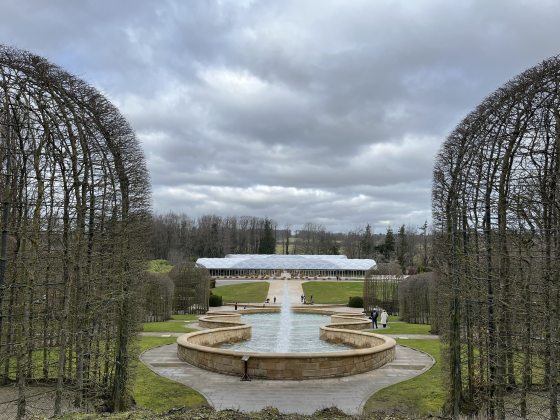
The Alnwick Garden. Photo by E. Yvette Weaver.
Mikey Leach, the new Head Gardener, had recently completed his initial months in the role and was beginning to shape his vision for the garden's future. I met with Trevor Jones, the former Head Gardener, who had spent 12 years at TAG. Trevor came prepared to share some history regarding past partnerships, garden shows, and the garden’s relationship with the broader horticultural community. Even though I was to work closely with the horticulture team, my desk was situated alongside the marketing team, led by the dynamic Ian McAllister, who loved brainstorming ideas with me. At one point, Mark stated of my project, “There are no limits.” These conversations helped me build a strategy and envision its future direction.
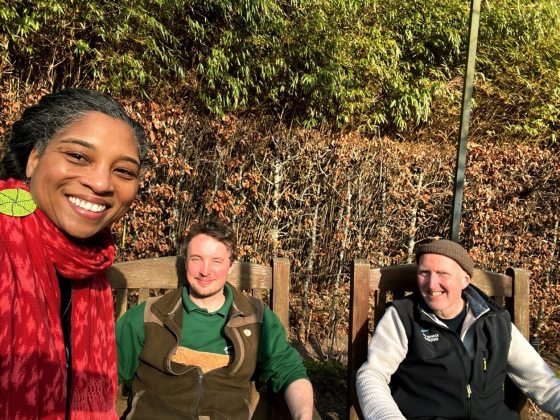
From left: Fellow E. Yvette Weaver, The Alnwick Garden’s new Head Gardener Michael Leach, and former Head Gardener Trevor Jones. Photo by E. Yvette Weaver.
Outside of the garden, I found myself falling for the North East. In my off-hours, I hiked the rolling hills, explored coastal fields and medieval castles, and wandered the heathland stretching toward the Scottish Borders. I even had the opportunity to meet with Longwood’s former Vice President of Engagement & Learning Sarah Cathcart, now Director, Learning & Engagement at Royal Botanic Gardens Edinburgh, along with visiting many gardens in the region. All of this, combined with a growing network of new friends, drew me closer to the community and inspired me to consider numerous ways to highlight TAG through a heartfelt marketing strategy. Both my professional and personal experiences during this time were invaluable.
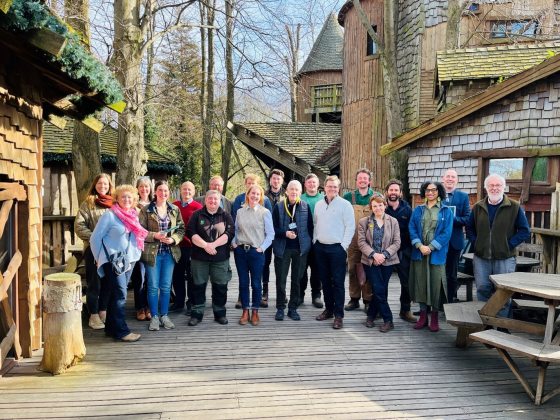
Garden representatives from England’s North East Region, the Northumberland Tourism Council, with The Alnwick Garden’s Head Gardener Michael Leach, The Alnwick Garden’s Chief Executive Officer Mark Brassell, and Fellow E. Yvette Weaver. Photo by E. Yvette Weaver.
My fellowship provided me with a firsthand opportunity to see how connected and supportive the public garden community is in this region. Drawing from my learning at Longwood about the Philadelphia region’s positioning as America’s Garden Capital, I proposed the idea of forming a coalition of public gardens in England’s North East to boost tourism and foster collaborative opportunities to enhance revenue. This would build upon the ideas Mikey and I discussed regarding ways for the horticulture team to gain more training and exposure in the field, while also increasing the number of visitors to the garden. With five weeks left in my placement, Mark expressed his desire for the initial meeting to take place while I was still there.
Standing in front of a room full of representatives from public gardens and the North East Tourism Council was a defining moment for me. This project was about more than just boosting numbers; it focused on building connections to collectively highlight the regional story of gardens, showcase the beauty of The Alnwick Garden, and create opportunities for the amazing horticultural team to develop their professional skills.
Our multiple experiences as Fellows have highlighted my strengths as a leader, with themes like originator, empathy, connections, initiative, and strategy focused on throughout the program. The garden placement was an opportunity to actuate these strengths, along with my other learnings at Longwood, by embracing uncertainty, building relationships across departments, and leading with curiosity, wonder, and purpose.
Editor’s note: Interested in joining the Fellows Program to advance your career in public gardens? Know a public garden professional looking to accelerate their skills? Applications for the 2026–27 Fellows cohort open June 1, 2025.
